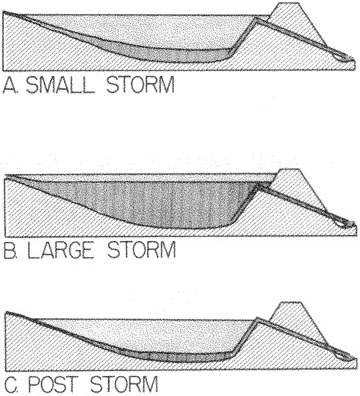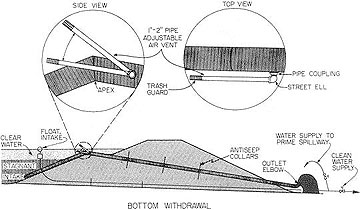This guide describes the operation and maintenance of a unique new principal (pipe) spillway for a pond or lake supplying clean water for municipalities, recreation, domestic use or trickle irrigation. Operating on the siphon principle, the bottom-withdrawal spillway has an adjustable air-vent tube that allows you to vary the reservoir water level for weed or wildlife management. This bottom-withdrawal spillway will normally lose fewer fish from the reservoir than a conventional surface-withdrawal spillway. By plumbing the discharge end to the intake of a large irrigation system, this spillway can also serve extra duty as the withdrawal pipe during the irrigation season when it is not needed as a spillway.
An existing hooded or canopy type surface-withdrawal spillway can be converted to a bottom-withdrawal spillway.
Favorable situations
When it is desirable to pass more sediment than normal through the reservoir or to improve water quality, the bottom-withdrawal spillway is recommended if:
- A pond has large inflows or a watershed-to-pond surface area ratio greater than 20 to 1;
- The inflowing water is usually muddy;
- The inflow has a high nutrient load (that is, the watershed is well fertilized or contains livestock); or
- The pond owner does not control the watershed and the second and third situations could occur at any time.
The bottom-withdrawal spillway is not needed when 100 percent of the watershed is in grass, forest or pavement. This spillway is not to be used for sediment basins or grade-stabilization structures intended to trap sediment.
Water quality control
The quality of water stored in a reservoir improves with time between runoff events as algae and aquatic plants use nutrients and as algae and suspended sediment are deposited. Conventional surface-discharge spillways permit this cleaner water to be discharged during the next runoff event (Figure 1A) and to be replaced by surface runoff, which is usually of lower quality (Figure 1-C). The water purification process then begins all over again with the additional new sediment and nutrients trapped in the reservoir. This process improves the quality of water discharged from the reservoir, but it also stores the poorest quality water and, because of sediment buildup, shortens the useful life of the reservoir.
The bottom-withdrawal spillway is designed for reservoirs that need to store the best possible water from a given watershed. If the reservoir is full, this spillway allows the lower quality stormwater to be discharged as soon as it reaches the intake (Figure 2-A). This inflow will go to the bottom of the reservoir with minimum mixing because it has a higher density caused by suspended sediment, dissolved solids or lower temperature. The water quality of the discharge will be more nearly that of the original stream prior to construction of the dam except for sand-size or larger particles that are deposited as the runoff water enters the reservoir. The cleanest water remains in the reservoir because it is less dense than the inflow and will float up into the "flood storage area" of the reservoir (Figure 2-B).


After discharge is completed, the clean water will still be in the reservoir (Figure 2-C). Thus, the quality of the stored water is superior when compared to the muddy water stored in a reservoir with a surface discharge spillway (Figure 2-C versus Figure 1-C). Other benefits include lengthened reservoir life and better conditions for recreational activities such as fishing and swimming.
The normal water level of the reservoir is controlled by the high point in the pipe. However, if the pipe (siphon) primes, the water level can be drawn down to the desired level. This is controlled by an adjustable air vent that simply allows air to enter the pipe and the siphoning will stop. With the ease of controlling the water level, this spillway can be used to lower the water level to control aquatic weeds and improve wildlife habitat. Likewise, stagnant water that accumulates in the bottom of the pond during the summer may be discharged before it mixes with the clean surface water during the "fall overturn," which is usually in September.
Sediment control
Most farm ponds trap 85 to 99 percent of entering sediment. If the pond is intended for clean water storage and recreation, sediment deposition defeats its intended purpose. If sediment is not 100 percent controlled in the watershed, a sediment basin or trap immediately upstream of the pond may be necessary.
Ideally, a sediment basin should be a large, shallow pond with a surface-discharge spillway that skims the cleanest water from the surface. Sand, silt, and sand-size aggregates are easily trapped in sediment basins. The remaining suspended clay will flow through the pond downstream and be discharged by the bottom-withdrawal system. Even a deep, narrow sediment basin is better than none at all. The sediment basin can be either an excavation in the stream channel or a small, above-grade structure. The advantage of the excavated type is that it will return to its natural condition when full. The above-grade type will remain a liability and have to be maintained to prevent failure and mass movement downstream.
Bottom-withdrawal spillway features
Depth of intake
A deep intake not only removes more sediment and nutrients, but it also prevents loss of fish. Ponds greater than 8-feet deep usually develop an anoxic zone near the bottom during warm weather. Because fish don't inhabit the zone, an intake greater than 8-feet deep will lose very few fish from the pond.

Location of the apex
The elevation of the apex determines the normal pool level. However, the apex may be buried in the fill or left exposed on the upstream side of the dam. Burying the apex may be desirable to prevent ice damage in northern states or when using plastic pipes (Figure 3).
Air vent
The air vent is normally set at the elevation of the apex. However, if it is desirable to lower the water level after a storm or after manual priming, the air vent should be set at the desired elevation. Also, if the spillway is manually primed, the air vent can be capped and siphoning will continue until the cap is removed. (See priming section below.)
Outlet elbow
The elbow on the outlet end of the pipe serves three purposes. It acts as an aerator so the anoxic bottom water is aerated before it enters the stream, as an energy dissipator so a deep plunge pool doesn't develop and as an air lock so siphoning will begin at lower water levels (low flows) and will continue until air enters the upstream air vent.
Anti-seep collars
Anti-seep collars are used to prevent water flow external to the spillway pipe. These collars are usually made of steel, plastic or heavy butyl rubber.
Manually priming the spillway
The spillway will automatically prime, or flow full and siphon, when the water level rises a half-pipe diameter or less above the apex if the air vent is submerged. However, there may be times when it is desirable to manually prime the spillway.
The first step is to plug, or "stopper," the outlet end. The second step is to fill the pipe with water. This can be done one of three ways:
- If there is a trickle flow, allow it to fill by itself by leaving the air vent open to the atmosphere
- Apply a vacuum to the air vent (the vacuum from the manifold of a spark-ignition engine will usually suffice)
- Attach a hose from the stock water line or another source to the downstream end of the pipe or through the plug to fill the pipe
The third step in priming the pump is to cap or plug the air vent or clamp the vacuum line. The fourth and final step is to remove the plug from the outlet end and stand back. It is not necessary to remove all the air from the spillway pipe; as the flow increases, the water will remove it.
The water can be stopped manually by removing the air vent cap. The pond water level can be lowered to most desired levels by lowering the air vent to that level. The water flow will stop automatically when the water reaches the air vent level.
Other considerations
Water in the bottom of ponds will not fall below 39 degrees Fahrenheit during winter months. Therefore, if water continues to flow, the bottom-withdrawal spillway should not freeze. However, if the water level of the pond is low when freezing occurs, an ice plug could form upstream of the apex and restrict flow if a freezing rain produces runoff. This is a rare situation; runoff usually occurs when air temperatures are above freezing.
Plastic pipe may be used for the spillway, but extra care must be exercised during installation. Also, a weep hole should be drilled in the bottom of the outlet elbow to prevent freezing during no-flow conditions in the winter.
The air vent should be protected from floating debris that may plug it and cause prolonged siphoning. A screen may be clamped to the end of the air vent, or the air vent may be put into a larger screened-in enclosure.